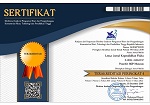Pengaruh Model Pembelajaran Aktif Berbasis Inkuiri (ABI) Terhadap Kemampuan Berpikir Kritis Siswa
DOI:
https://doi.org/10.33394/j-lkf.v6i1.930Keywords:
Active Learning, Inquiry Based Active Learning Model (ABI), Critical Thinking AbilityAbstract
[Title: The Effect of Inquiry-Based Active Learning (ABI) on Students' Critical Thinking Ability]. The critical thinking ability is the ability to learn and analyze information through skills: interpretation, analysis, evaluation, inference, explanation and self-regulation. Inquiry-based active learning model (ABI) is a learning model that accumulates active and inquiry learning which aims to develop students critical thinking ability through phases: 1) introduction and establishing sets; 2) presenting cognitive conflicts; 3) submitting the hypothesis; 4) collecting data (experiment) for hypothesis testing; 5) formulate explanations and/or conclusions; 6) reflection. This research aims to determine the effect of inquiry-based active learning model (ABI) on students’ critical thinking ability. This research is quantitative research (quasi-experiments), this experimental research uses pretest-posttest control group design. This research is used cluster random sampling. The sample in this research amounted to 37 students as experimental class and 34 students as control class. The inferential analysis is used to test the influence of inquiry-based active learning model (ABI) in a review of improvement of students’ critical thinking ability. Hypothesis test results also show t-test value lower than t-table value, so it can be stated that the Inquiry-Based Aktive Learning Model (ABI) has a positive effect on critical thinking ability of X-GEO at SMKN 3 Mataram school year 2017/2018.References
Arends, R. (2012). Learning To Teach. Ninth Edition. New York: Mcgraw-Hill.
Ariyati, E. (2010). Pembelajaran Berbasis Praktikum Untuk Meningkatkan Kemampuan Berpikir Kritis Mahasiswa. Jurnal Matematika dan IPA. Vol. 1 No. 2.
Bailin, S., Case, Rs., Coombs, J. R., Daniels, L. B. (1999). Common Misconceptions of Critical Thinking. Journal of Curriculum Studies. 31(3),269-283.
Eggen, P & Kauchak, D. (2012). Strategi dan Model Pembelajaran. Jakarta: Pearson Education Inc.
Facione, P. (2011). Critical Thinking. What it is and Why Its Counts. Measured Reason and The California Academic Press.
Fisher, A. (2003). Critical Thinking An Introduction. Cambridge: Cambridge University Press.
Heuvelen, A. V. (2001). Millikan Lecture 1999 : The Workplace, Student Minds, And Physics Learning. Am. J. Phys. 69(11).
Nieveen, N. (1999). Prototyping to Reach Product Quality. Kluwer Academic Publisher.
Pintrich, P. R. (1999). Motivational Beliefs as Resources for and Constraints on Conceptual Change. In W. Schnotz, S. Vosniadou, dan M. Carretero (Eds.), New perspectives on conceptual change. Amsterdam: Pergamon.
Prayogi, S. & Muhali. (2015). Pengembangan Model Pembelajaran Aktif Berbasis Inkuiri (ABI) untuk Mengembangkan Keterampilan Berpikir Kritis Mahasiswa. Prisma Sains: Jurnal Pengkajian Ilmu dan Pembelajaran Matematika dan IPA IKIP Mataram. 3(1), 346-351.
Prayogi, S. (2013). Implementasi Model Inquiry untuk Mengembangkan Kemampuan Berpikir Kritis Mahasiswa Pendidikan Fisika. Laporan Hasil Penelitian. LPPM IKIP Mataram.
Prayogi, S., dan Asy’ari, M. (2013). Implementasi Model PBL (Problem Based Learning) untuk Meningkatkan Hasil Belajar dan Kemampuan Berpikir Kritis Siswa. Prisma Sains: Jurnal Pengkajian Ilmu dan Pembelajaran Matematika dan IPA IKIP Mataram, 1(1), 79-87.
Sanjaya, (2011). Strategi Pembelajaran Berorientasi Standar Proses Pendidikan. Jakarta: Kencana.
Samdas. G. (2012). Pembelajaran Inovatif. Lembaga Pengkajian Pembaharuan Hukum dan Kebijakan Publik (LP2HKP). Palu.
Syah, M. (2010). Psikologi Pendidikan .Bandung: Rosdakarya.
Sternberg, R. (1986). Critical thinking: its nature, measurement, and improvement. http://eric.ed.gov/PDFS/ED272882.pdf.
Usdalifat, S. (2016). Pengaruh Model Inkuiri Terhadap Kemampuan Berpikir Kritis dan keterampilan Proses Siswa Pada Mata Pelajaran IPA Kelas VII SMP Negeri 19 Palu. Jurnal Sains dan Teknologi tadulako, 5(3),-.
Thompson, C. (2011). Critical Thinking Across The Curriculum: Process Over Output. International Journal of Humanities and Social Science, 1(9),-.
Tritanto. (2007). Model Pembelajaran Terpadu dalam Teori dan Praktek. Jakarta: Prestasi Pustaka.
Woolfolk, A. (2009). Educational Psychology. Bagian Pertama. New York: Pearson.
Downloads
Published
How to Cite
Issue
Section
License
Authors who publish with Lensa: Jurnal Kependidikan Fisika agree to the following terms:
- For all articles published in Lensa: Jurnal Kependidikan Fisika, copyright is retained by the authors. Authors give permission to the publisher to announce the work with conditions. When the manuscript is accepted for publication, the authors agree to automatic transfer of the publishing right to the publisher.
- Authors retain copyright and grant the journal right of first publication with the work simultaneously licensed under a Creative Commons Attribution-ShareAlike 4.0 International License that allows others to share the work with an acknowledgment of the work's authorship and initial publication in this journal.
- Authors are able to enter into separate, additional contractual arrangements for the non-exclusive distribution of the journal's published version of the work (e.g., post it to an institutional repository or publish it in a book), with an acknowledgment of its initial publication in this journal.
- Authors are permitted and encouraged to post their work online (e.g., in institutional repositories or on their website) prior to and during the submission process, as it can lead to productive exchanges, as well as earlier and greater citation of published work (See The Effect of Open Access).

This work is licensed under a Creative Commons Attribution-ShareAlike 4.0 International License.



